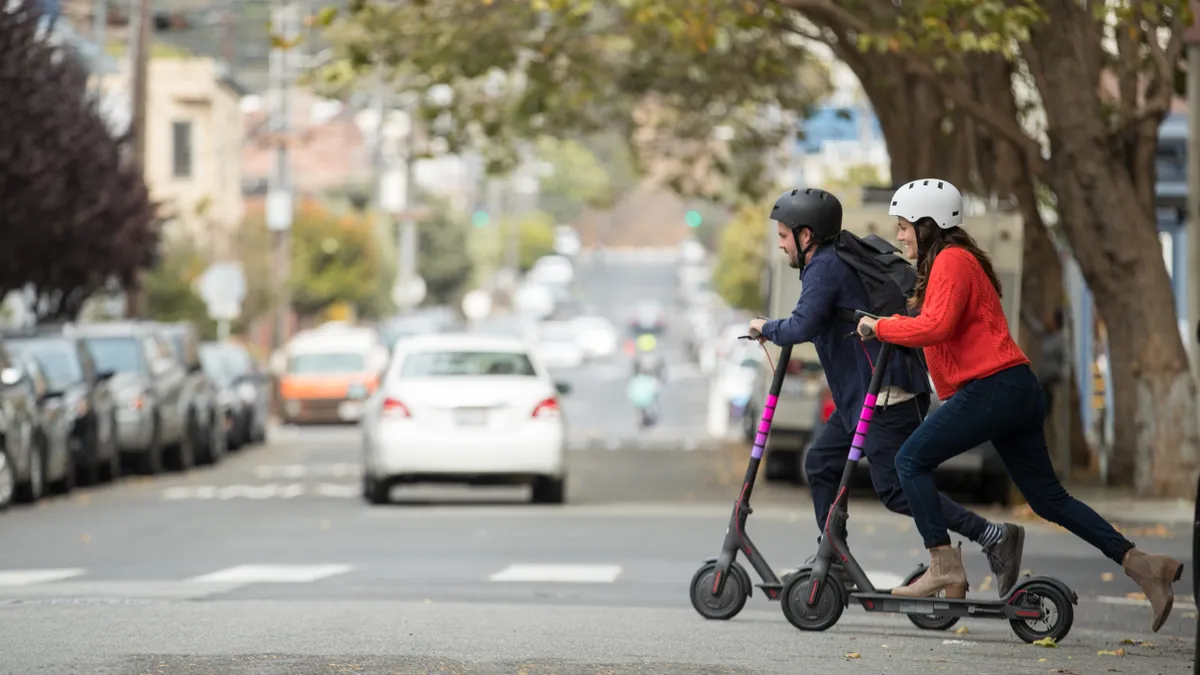Dive Brief:
- Chicago should embrace micromobility, not just e-scooters, according to a new report by the Chicago Council on Global Affairs. The report includes scooter policy suggestions for Chicago as the city updates its guidelines following its initial four-month scooter pilot in 2019.
- The city should invest in micromobility infrastructure that can help improve congestion, livability and the environment, "but let companies pay e-scooter specific costs," the report reads.
- Chicago's e-scooter program should also be extended to the city's downtown area; factor recreational trips; pursue solutions aimed at safety clutter and sustainability; and prioritize equity and affordable access, the report reads.
Dive Insight:
Chicago's initial scooter pilot ran from June through October last year, and while it was popular generally with residents, it still proved problematic at times.
The pilot included 10 different scooter companies — Bird, Bolt, grüv, Jump, Lime, Lyft, Sherpa, Spin, VeoRide and Wheels. Each operator was allowed 250 devices within a 50-square-mile geofenced area on the west and northwest side of the city.
The results of the pilot were mixed. The city analyzed 407,296 trips, yielding the following information:
-
72% of riders were white, 65% were male
-
42% of riders decreased ride-hail use
-
80.8% of scooters were parked properly
-
192 emergency room visits were reported
-
116 tons of CO2 were potentially reduced
The results pose many questions about the pitfalls of the program, according to the report. Those shortcomings include safety concerns, uncertain long-term business prospects, net carbon impact, and the reach of ridership, with most users being young, male and white.
"The wrong question is to ask how to accommodate e-scooters," report author Samuel Kling told Smart Cities Dive in an email interview. "The question cities need to ask is, 'How can we approach new technology so that it serves larger goals?' Starting from that vantage point, it makes sense for Chicago to seriously explore how very small vehicles generally can reduce congestion, lower trips' environmental costs, improve mobility, and better people's quality of life."
But despite the pilot's limitations, scooters and micromobility still hold the potential to replace short car trips, with 51% of Chicago car trips being under three miles, according to the report. Micromobility devices can also be deployed to underserved neighborhoods with large minority populations, as recently seen with Divvy's Far South bike-share program, Streetsblog Chicago reports. And the vehicles can help create safer, multimodal streets.
Chicago's ability to carry out its e-scooter program will also depend on "unfettered access to the data it needs," the report reads. That will include data in accordance with the Mobility Data Standard, a program that has been met with controversy in Los Angeles as Uber-owned Jump has said that sharing such data would be a violation of customer privacy.
Looking ahead, the number of scooter operators to be included in Chicago's second pilot could be much smaller than the initial pilot’s ten companies. Cities are seemingly cutting back on the number of scooter operators within their city, but increasing the sizes of remaining operators' fleets.
In Washington, DC, for example, the District Department of Transportation has reduced the number of scooter operators by half, according to DCist. But the city will allow the permitted four operators to deploy up to 10,000 scooters — more than double the number originally cruising DC streets.
"Chicago can accelerate its own trial-and-error process by looking to other cities," Kling said. "San Francisco has been very intentional about making sure scooters are affordable and accessible. Los Angeles has been a leader on data. Paris aggressively embraced e-scooters, but now they’re looking to reduce the number of operators and lower vehicle caps. So everyone is experimenting, and although every city is different, it helps to know what works in each place and what doesn’t."
Correction: This story has been updated to reflect the correct percentage of scooters properly.












